
THE NEW SURVEILLANCE ERA:
Visibility Beats Productivity for RTO & Remote
June 6, 2024
Whether in office or online, employees feel pressured to look productive, resulting in the Green Status Effect.

With employee engagement, retention, and company culture hanging in the balance, it's important for leadership and HR to get hybrid and flexible working policies right. BambooHR surveyed 1,504 full-time US employees, including 504 human resources professionals, to understand what they think about returning to office, working from home, and hybrid/flexible models.
Read on to explore the results, and gain insights from HR expert Anita Grantham on what you can do to drive both productivity and employee satisfaction at your organization.
Key Takeaways
- Half of workers (52%) prefer to work remotely, while 2 out of 5 (39%) prefer to be in the office.
- The majority of both remote (88%) and in-office (79%) workers take actions to prove they’re online and working.
- 42% of employees who returned to the office say they feel like they are showing up just for visibility.
- Close to a third (32%) of managers admit the desire to track employees was a main goal for their company’s RTO mandate.
- 22% of HR pros admit their organization doesn’t have any metrics to measure a successful return to office policy.
- A quarter (26%) of employees say a greater divide has developed between remote and non-remote workers since RTO, and close to half (44%) of hybrid/in-office employees say they don’t have as strong of a relationship with remote colleagues compared to those they see in office more often.
Visibility Equals Productivity for Remote and In-Person Workers
Whether they’ve been called back to the office or are working in a remote or hybrid environment, office workers are taking actions to make themselves more visible. The goal: to prove their productivity to colleagues and management.
The vast majority of in-office (79%) and remote (88%) workers feel the need to prove they’re being productive.
How Employees Prove They’re Working
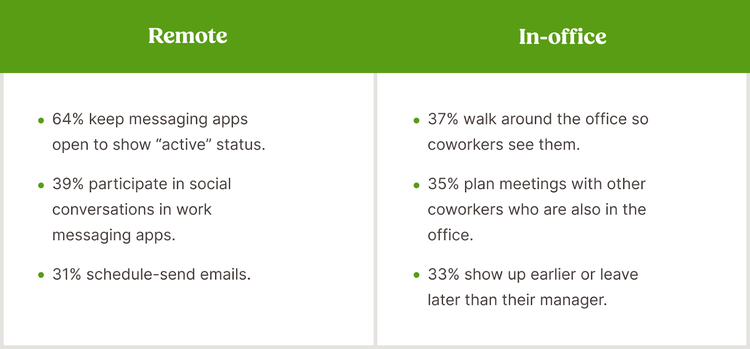
The Green Status Effect
While all workers are taking steps to demonstrate productivity, it’s among remote employees that the "Green Status Effect" has emerged. This term refers to the tendency to keep work messaging apps perpetually open, displaying a green "active" status to imply you’re online and actively engaged in work.
Nearly two-thirds (64%) of remote workers in our survey admit maintaining this constant online presence, even when they may not be actively working.

The motivation behind this behavior is the need to prove their productivity and dedication to their colleagues and managers, as remote work environments often lack tangible performance metrics.
In an in-person setting, in-office workers experience their own version of the Green Status Effect—actively socializing and moving around the office (37%) to be seen by their colleagues and superiors.
Whether remote or in-person, this behavior is driven by the desire to create a visible presence and maintain a positive image within the organization.
Almost Half of Employees Feel Pressure to Be “Seen” at Work

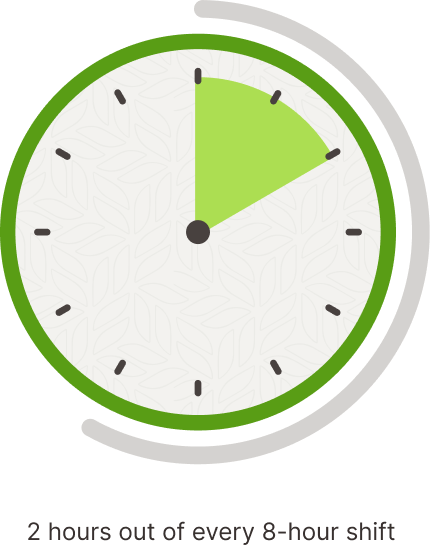
But the belief that in-person work inherently makes people more productive isn’t supported by the data.
Workers (both in-office and remote) only work for around three quarters (76%) of a 9-to-5 shift; the other quarter is spent socializing, procrastinating, or doing non-work-related tasks. Put simply, all workers typically spend 2 hours out of every 8-hour shift not working, which isn’t surprising given our attention spans are shrinking.
When it comes to who’s more productive overall, in-office workers spend around one hour more socializing than their remote counterparts, while remote workers spend that time on work-related tasks and responsibilities.
Vague expectations or goals around returning to the office may not only be encouraging performative Green Status behaviors—it’s actively eroding employee trust.
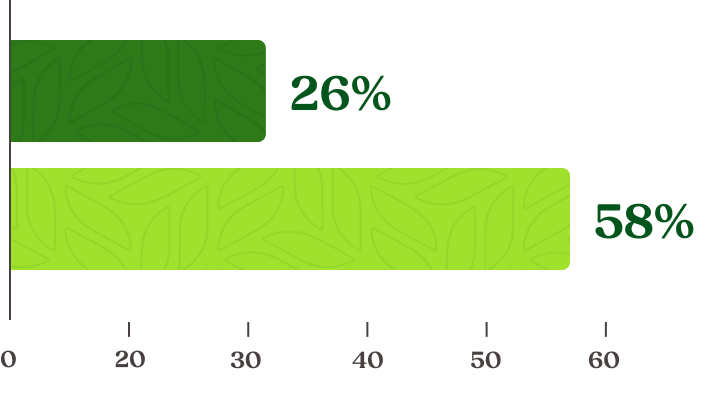
Clear Expectations Prevent Performative Displays from Employees

"It's essential to create a work culture that values both social connection and productivity. Encouraging team bonding activities, open communication, and flexibility in work arrangements can foster a sense of community while empowering employees to excel in their roles. I’ve found the key is to not separate the two by building teams that can laugh and work hard simultaneously. Clear expectations and regular open conversations ensure that employees are hitting their targets, understand expectations, and feel included.”
Anita Grantham | Head of HR | BambooHR
Neither Remote or In-Person Wins as Employees' Preferred Work Mode Depends on Their Needs
52% of Workers Prefer to Work from Home, Prioritizing Work-Life Balance

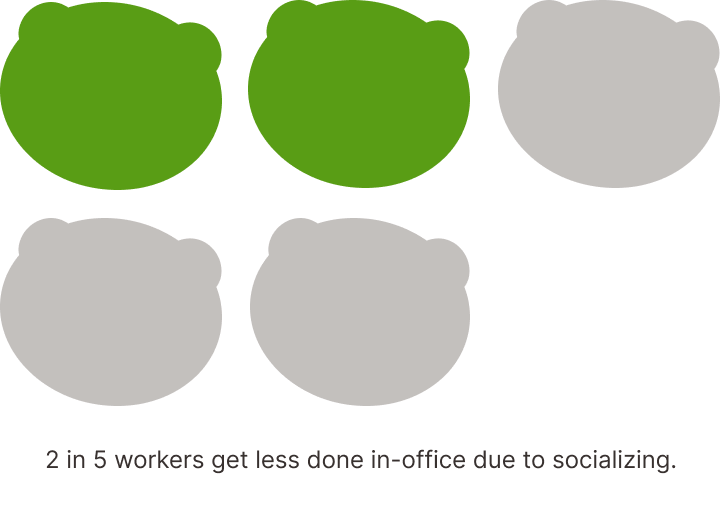
For many employees, the social aspect of working in-person is a distraction rather than a benefit, stating that remote work means they “don’t have to listen to coworkers gab and gossip.” Nearly two in five (39%) workers say they get less work done in-office because of socializing with coworkers.
Employees who prefer working from home also feel strongly about their productivity, as over half (56%) say they do better work remotely.
39% of Workers Prefer to Work In-Office, Prioritizing Social Aspects

Unsurprisingly, 81% of in-office employees like the opportunities for socializing, networking, and visibility with bosses. But that doesn’t mean that they’re less concerned about their productivity than their remote counterparts.
“I’m more focused in the office as opposed to home where I can veer off to do other things.”
“My kids at home sometimes distract me.”
The majority of employees who prefer in-office work say it’s because they feel they do better work in the office (74%), and close to half (48%) of post-RTO workers say their work results have improved since going back to the office.
Young Workers Least Likely to Want to Work Remotely
Preference for Working in the Office

Additionally, the interaction patterns across generations also differ significantly. Younger generations tend to spend more time socializing than older generations, with Gen Z socializing for around 30 more minutes a day on average than Boomers and Gen X. This desire for socialization and connection is one reason why Gen Z has a higher preference for in-office or hybrid work models. However, for Gen Z, in-office and 9–5 don’t mean the same thing; they still prefer flexibility, including working hours.
With the time they save by socializing less, older generations are spending more time on work tasks and responsibilities than younger generations, with Boomers spending a full hour more on average than Gen Z and Millennials.
Remote Work Facilitates Accessibility for Many Employees
Workers with disabilities prefer remote work and would consider leaving if RTO was mandated at their organization:
- 63% of workers with disabilities prefer remote work, compared to 51% of non-disabled workers.
- 43% of workers with disabilities say they’d consider leaving if RTO policies happened at their organization, compared to only 27% of non-disabled employees.
The Impact on Connection in a Hybrid Work Environment
One of the largest issues companies face is bridging the disconnect between remote/hybrid workers and their in-office peers.
More than two in five (44%) hybrid/in-office employees say they don’t have as strong a relationship with remote colleagues as those they see in office more often. Since having an RTO mandate, more than a fourth (26%) say a greater divide has developed between remote and non-remote workers.

Individual Arrangements Are Most Successful
“Work policies should be designed to support all employees, regardless of their work location. Whether in the office, remote, or part of a hybrid team, it's crucial to create policies that prioritize flexibility, inclusivity, and employee wellbeing in addition to productivity. By tailoring policies to meet the diverse needs of the workforce, leaders ensure employees feel valued, supported, and empowered to do their best work, whatever that looks like."
Anita Grantham | Head of HR | BambooHR
Some Executives and HR Admit RTO Is Meant to Make People Quit
The connection between RTO mandates and workforce downsizing—also known as quiet firing—is not lost on workers, many of whom consider an RTO mandate to be a layoff precursor. Vague reasoning and missing productivity metrics leave employees to assume the worst, which is only fueled by already-low employee happiness and trending anti-work content on social media. One in four (28%) remote workers fear they'll be laid off before their in-office coworkers.
Nearly two in five (37%) managers, directors, and executives believe their organization enacted layoffs in the last year because fewer employees than they expected quit during their RTO. And their beliefs are well-founded: One in four (25%) VP and C-suite executives and one in five (18%) HR pros admit they hoped for some voluntary turnover during an RTO, proving, in some cases, why RTO mandates are layoffs in disguise.
% that hoped for voluntary turnover during RTO

By using RTO mandates to quietly fire as a workforce reduction tactic, companies are losing talent and morale among their employees. Nearly half (45%) of the employees who have experienced RTO report significant talent loss within their organizations—talent that was highly valued and wished to be retained.
Moreover, the discontent with return to office policies is strong among employees, with more than one in four (28%) stating they would consider leaving their positions if subjected to such mandates. This level of dissatisfaction could lead to a further drain of talent, affecting not just morale but also the stability and innovation potential of the workforce.
More than one in four (28%) employees would consider quitting if RTO policies occurred at their company.
Compensation and Work-Life Balance Are Driving Factors in Happiness
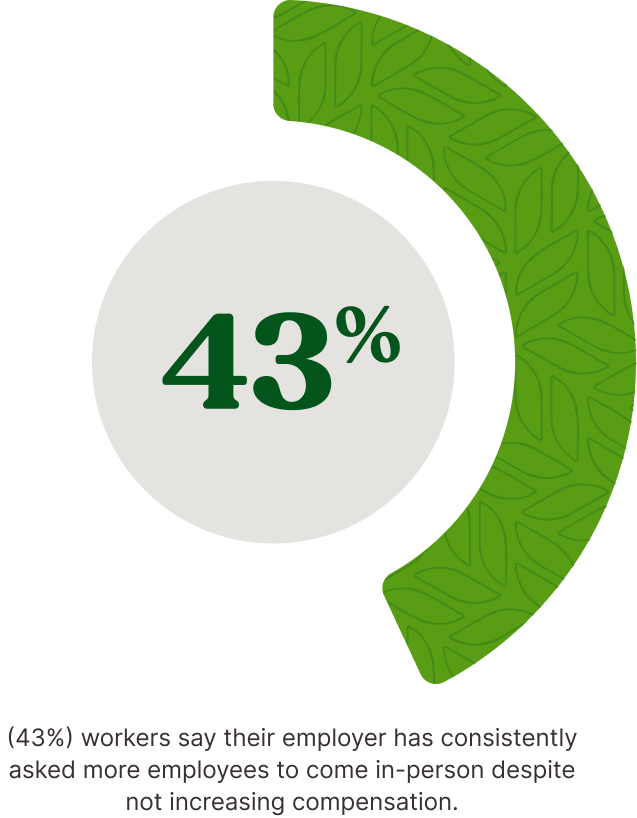
BambooHR Employee Happiness Index reports show employee happiness hit its all-time low at the end of 2023, and although work modes are a key factor, it’s certainly not the only one. This return to office survey also reveals pay is a major aspect. Over half (59%) of employees say that compensation in comparison to inflation is the biggest influence on their happiness at work.
Many employees also expect different compensation based on being called back to the office. Two in five (43%) workers say that in the last year, their employer has consistently asked more employees to come in-person despite not increasing compensation.
Big Brother to Big Ideas: Navigating Hybrid Work with Employee Feedback
“The mental and emotional burdens workers face today are real, and the companies who seek employee feedback with the intent to listen and improve are the ones who will win employee loyalty and ultimately customer satisfaction. In a vacuum of information, employees will usually land on worst-case scenarios, so being transparent goes a long way.”
Anita Grantham | Head of HR | BambooHR

About BambooHR
Methodology
Employee Happiness Erodes in Q3 as The Great Gloom Continues
Is the Great Gloom loosening its grip? Not quite. The BambooHR Employee Happiness Index shows employee happiness continues its three-year decline.
First Impressions Are Everything: 44 Days to Make or Break a New Hire
70% of new hires decide whether a job is the right fit within the first month—including 29% who know within the first week. Onboarding makes all the difference.
31% of HR Managers Say They Need Better Employee Data Protection
Discover insights into employee perception and experience with data security—and how to better protect your workforce data.